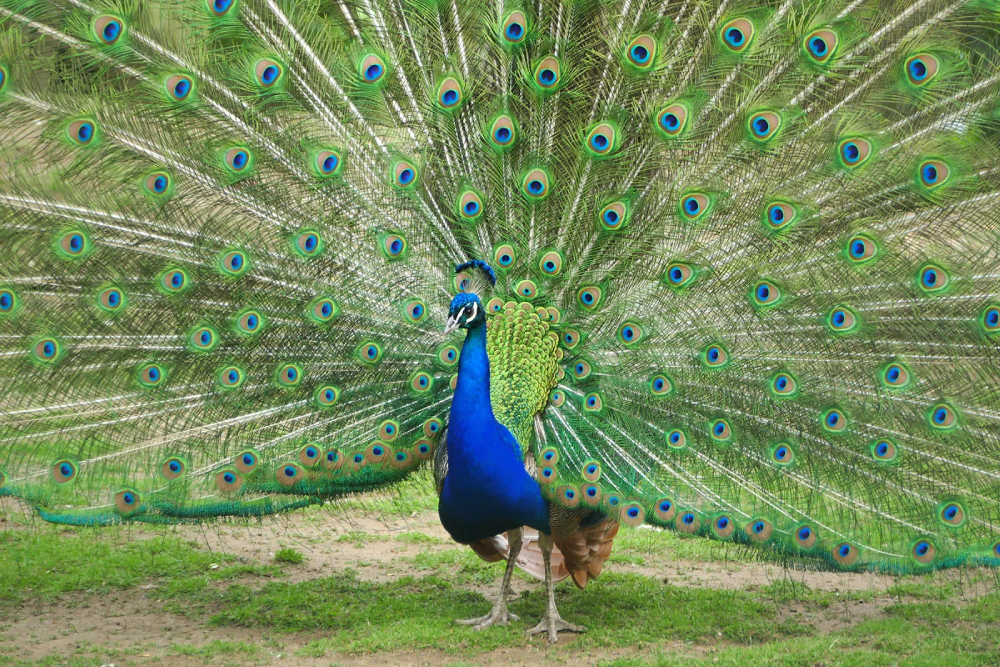The peacock, known for its dazzling plumage and iridescent tail feathers, is one of nature’s most striking and well-recognized birds. Belonging to the pheasant family, the term “peacock” technically refers only to the males of the species. While, the females are called peahens, and together they are referred to as peafowl. These birds are not only celebrated for their beauty but also for their fascinating behaviors. They have significant cultural and historical importance.
Species and Habitat
Peafowl belong to the genus Pavo, which includes two main species: the Indian peafowl and the Green peafowl. Additionally, the Congo peafowl belongs to a different genus but is often grouped with these birds due to similarities in appearance and behavior.
Indian Peafowl: The most well-known and widespread species is the Indian peafowl, native to the Indian subcontinent. These birds are found in a variety of habitats including forests, farmlands, and areas close to human settlements. They have been introduced to many other parts of the world, including the United States, Australia, and several African countries, where they have often become feral.
Green Peafowl: Native to Southeast Asia, the Green peafowl inhabits tropical forests and is more elusive than its Indian counterpart. This species is more solitary and less tolerant of human presence, leading to a decline in its population due to habitat loss and hunting.
Congo Peafowl: Found in the rainforests of the Congo Basin, the Congo peafowl is less flamboyant than the other two species. It has a more subdued coloration and lacks the long tail feathers that characterize the Indian and Green peafowl.
Physical Characteristics
The most distinguishing feature of the male peafowl, or peacock, is its extravagant tail, known as a train. The train consists of elongated upper tail coverts that can reach up to six feet in length and feature eye-catching “eyespot” patterns. These feathers are not actually the bird’s tail but are instead overlying the short, stiff tail feathers underneath.
The iridescence of peacock feathers is due to microscopic structures that reflect light in various ways, creating vibrant blues, greens, and golds. This structural coloration, as opposed to pigmentation, is a remarkable example of nature’s ingenuity.
Peahens, on the other hand, are more muted in color, typically featuring browns and grays. This cryptic coloration helps them blend into their surroundings, particularly when nesting, to avoid predators.

Behavior and Mating Rituals
Peafowl are ground feeders, foraging for grains, insects, small reptiles, and other food items. They are capable of flight despite their size and often roost in trees at night to stay safe.
The courtship display of the peacock is one of the most elaborate in the animal kingdom. During the breeding season, the male will fan out his train and perform a series of movements, shaking his feathers to produce a rattling sound that attracts the attention of nearby females. This display serves two primary purposes: to showcase the male’s fitness and genetic quality to potential mates and to intimidate rivals.
Peahens choose their mates based on the quality of these displays, preferring males with larger, more colorful, and symmetrical trains. This form of sexual selection has driven the evolution of the peacock’s tail to become more extravagant over time.
Cultural and Historical Significance
Peafowl have been revered by various cultures throughout history. In Hinduism, the Indian peafowl is associated with the deity Krishna, who is often depicted wearing a peacock feather in his hair. The bird is also linked to Saraswati, the goddess of wisdom and learning. In Buddhism, the peacock symbolizes compassion and watchfulness.
In ancient Greece, the peacock was associated with Hera, the queen of the gods, who placed the hundred eyes of her servant Argus into the bird’s feathers. This mythological connection contributed to the peacock’s status as a symbol of immortality and resurrection.
During the Renaissance, peacocks were a symbol of wealth and opulence, often kept in the gardens of European nobility. Their feathers were used in art and fashion, signifying luxury and sophistication.
Conservation and Challenges
While the Indian peafowl is listed as a species of Least Concern by the International Union for Conservation of Nature (IUCN), the Green peafowl is classified as Endangered due to habitat destruction, hunting, and human disturbance. Conservation efforts are crucial for protecting the habitats of these birds and ensuring their survival.
The Congo peafowl, with its limited range and specific habitat requirements, also faces threats from deforestation and poaching. Conservation programs focusing on habitat protection and anti-poaching measures are essential for preserving this unique species.
Conclusion
The peacock is a marvel of natural beauty and evolutionary success. Its resplendent plumage and intricate courtship displays have captivated human imagination for centuries. Beyond their aesthetic appeal, peafowl play a role in their ecosystems by controlling insect populations and dispersing seeds. Understanding and preserving these magnificent birds is not only important for maintaining biodiversity but also for continuing to appreciate the wonders of nature’s artistry.









